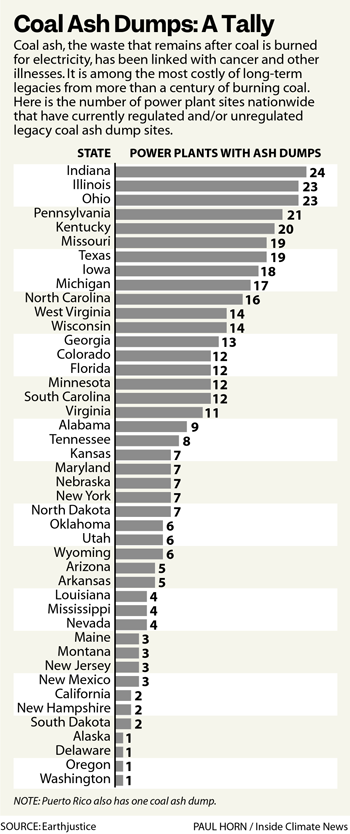EPA Reports “Widespread Noncompliance” With the Nation’s First Regulations on Toxic Coal Ash
ORLANDO, Fla.—There is “widespread noncompliance” with the nation’s first regulations on coal ash, the toxic waste left after coal is burned for electricity, the Biden administration recently announced.
In an enforcement alert issued late last year, the Environmental Protection Agency said the conclusion is based on “numerous facility assessments and inspections to determine compliance with regulatory requirements such as groundwater monitoring, corrective action implementation, and disposal unit closure.”
“Groundwater contamination at coal ash disposal facilities is a significant concern,” the document states. “Approximately 150 facilities have detected groundwater contamination from metals and other inorganic compounds released through coal ash disposal and EPA believes that number will continue to increase.”
The EPA did not identify the facilities where the contamination had occurred but said it made coal ash a national priority last year, a decision that concluded a regulatory process, and has finalized two settlement agreements with operators of facilities in Pueblo, Colorado, and Topeka, Kansas, to address problems there.
We’re hiring!
Please take a look at the new openings in our newsroom.
See jobs“We see this as the first shot across the bow informing the utilities and states and stakeholders that EPA indeed does find significant noncompliance with the coal ash rule,” said Lisa Evans, senior counsel at Earthjustice, a nonprofit organization litigating environmental issues.
Already the regulations had been under scrutiny because of what public interest groups characterized as a loophole allowing at least half a billion tons of coal ash to go unregulated. The EPA announced last year it would address the loophole and proposed a new rule aimed at extending federal monitoring, closure and cleanup requirements to hundreds of previously excluded older landfills, ponds and fill sites. The rule is on track to be finalized in May.
Evans said the new enforcement alert is significant because now not only has the EPA recognized the loophole, the federal agency has acknowledged sweeping noncompliance among facilities that are subject to the regulations. She wished, however, for more transparency related to the 150 facilities where groundwater contamination was detected.
“The public should be alerted to whether a facility in their community is out of compliance and whether EPA is going to do anything about it, or the state,” said Evans, whose organization represented public interest groups in litigation that led the EPA to address the federal loophole. The response came after Inside Climate News, WMFE in Orlando and NPR brought national attention to the loophole in late 2021 and early 2022.
The lack of transparency also concerned Laura Betts, climate resilience manager at the CLEO Institute, an environmental advocacy group. The Orlando-based community activist has been in touch for years with residents here over worries about the Stanton Energy Center, where dumping at a 90-acre coal ash landfill stopped just 52 days before the regulations took effect in 2015. The maneuver exempted the site from the new requirements.
“That’s scary because how can you act on it if you don’t know? How can you protect yourself if you don’t know?” she asked. “This plant is a few miles from a school.”
Coal ash is among the most costly of the long-term legacies left by more than a century of coal burning. The waste contains contaminants like mercury, cadmium and arsenic that can pollute the air and seep into groundwater. The contaminants are associated with cancer and other ailments.
“The public should be alerted to whether a facility in their community is out of compliance and whether EPA is going to do anything about it, or the state.”
The Orlando Utilities Commission, which operates Stanton, said the facility is compliant and has not received any word from the EPA indicating otherwise. The city-owned utility plans to phase out coal production within a few years and transition to cleaner energy sources.
“OUC has managed coal ash responsibly, working diligently to comply with applicable laws and regulations,” the utility said in a statement. “OUC is and will remain committed to our environmental responsibility by always striving to meet or exceed local, state and federal regulations now and in the future. We have always made it a point to do the right thing for our customers and community—and we will continue to do so.”
The EPA said in a statement to Inside Climate News that the “150 facilities referenced in the Alert does not speak to noncompliance but merely self-reported detected groundwater contamination, which is not a violation” of the regulations.
“This information was based on publicly available information EPA had at the time it was developing the document. The Alert does not refer to a specific number of facilities out of compliance, and therefore, we are not in a position to provide a list that we didn’t reference,” according to the statement. “Because of the website posting requirements built into the rule, EPA has ensured transparency for the public through access to information about the coal ash units and the environmental conditions at facilities located within their communities.”
Dan Chartier, executive director of the Utility Solid Waste Activities Group, said the industry group was disappointed by the concerns the EPA raised in the enforcement alert.
“To say it’s widespread, no we don’t agree with that at all,” he said, adding that the group’s members have been “working to comply with this rule since it was issued in 2015. Here we are nine years later, and they’re flagging noncompliance?”
When the Obama administration implemented the nation’s first regulations on coal ash in 2015, the rules applied to existing and new sites but exempted the waste at power plants that had already stopped generating electricity and sites that had already closed. The rules required cleanup and monitoring but only at the newer sites. Earthjustice identified 566 landfills and ponds at 242 coal plants in 40 states that were excluded, based on industry data provided to the EPA.

The regulations allow facility operators to close sites either by removing all the waste or maintaining it on site, and the rules involve measures aimed at preventing environmental contamination.
The EPA said in its enforcement alert that it had detected several kinds of noncompliance, including a failure to assess whether all the waste had been removed and whether the environment had been affected. The federal agency also said it had documented a failure to implement measures aimed at preventing future contamination and establishing an adequate groundwater monitoring network, including installing a sufficient number of wells.
Problems at the Comanche power station in Pueblo, Colorado, led the EPA to finalize a settlement agreement in May 2022 with the Public Service Company of Colorado, most notably over a lack of adequate groundwater monitoring, the agency said. The company must address the problems and pay a $925,000 fine.
“We’re implementing a series of steps to bring our management of coal ash facilities at Comanche in alignment with the U.S. Environmental Protection Agency’s (EPA) interpretation of the Coal Combustion Residuals Rule (CCR) as part of the agreement we entered in 2022,” parent company Xcel Energy said in a statement to Inside Climate News.
A second settlement agreement in November 2022 involved the Tecumseh Energy Center in Topeka, Kansas, where the federal agency said Evergy, Inc., failed to comply with closure and post-closure requirements and also did not comply with groundwater monitoring requirements. That company also must address the problems and pay a $120,000 fine. Evergy said in a statement to Inside Climate News that it disagreed with the EPA’s assessment of Tecumseh.
“EPA’s interpretation of the rule has changed,” the statement reads. “Rather than go through a long, expensive legal process, we agreed to settle the matter with EPA and follow the EPA’s current interpretation going forward. The groundwater in question does not impact area residents, wildlife or water supplies.”
The 2015 regulations came after major disasters. One occurred near Knoxville, Tennessee, in December 2008, when a levee that was holding a mountain of sodden ash suddenly broke loose from the Tennessee Valley Authority’s Kingston power plant. Some 300 acres were smothered. The ash spilled into two rivers. Three homes were destroyed, and dozens more were damaged.
In the years since, hundreds of cleanup workers have fallen ill, and many have died. Then in 2014, tens of thousands of tons of coal ash spilled from a Duke Energy power plant into the Dan River in Eden, North Carolina, affecting 70 miles of the watershed downstream.
The two settlement agreements represent a small start toward addressing the widespread noncompliance, said Abel Russ, senior attorney at the Environmental Integrity Project, a nonprofit advocating for more enforcement of environmental laws and a plaintiff in the lawsuit that led the EPA to address the loophole. The environmental impact is expected to grow, he said.
“There’s so much noncompliance out there,” he said, adding that if he were living near a coal ash site, “I would be thinking about my kids and grandkids and what kind of groundwater they’re going to have 50 years from now.”
Share this article
Disclaimer: The copyright of this article belongs to the original author. Reposting this article is solely for the purpose of information dissemination and does not constitute any investment advice. If there is any infringement, please contact us immediately. We will make corrections or deletions as necessary. Thank you.







